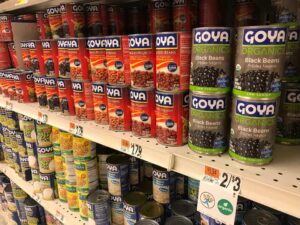by Andrea Traietti on September 3, 2020
Opinion
by Joseph Kulesza ’22
Opinion Staff

If you asked someone in 2010, “What is the commonality between face masks, going to school, and Goya canned beans,” your question would likely be met with a confused stare rather than a verbal response. Before the age of COVID-19 and today’s climate of mounting political divisiveness, disagreements over such frivolous topics seemed more likely to get on Comedy Central rather than CNN or the Wall Street Journal.
However, for all of us living in the present time, the insanity that comes along with a polarized political system seems all too normal, so much so that what seemed insane only a decade ago is the new normal of the present day. In order to successfully tackle the problems America faces today, we as a society need to focus more on our shared humanity and end our culture of “otherness.”
Today, America is experiencing levels of political discord that are unlike anything the country has faced in its 244-year history. “Liberal” and “conservative” have become such charged words that they are almost considered insults rather than descriptive words meant to characterize sets of ideological beliefs.
The once applicable bell curve of political party distribution has been flattened, with moderates and independents fleeing to either opposing end, petrified to be caught anywhere near the median.
This trend is not a topic of pure speculation but has been tracked by Pew Research. Over the past 20 years, “The number of Americans in the ‘tails’ of this ideological distribution has doubled from 10% to 21%.”
This shift represents “both Democrats moving to the left and Republicans moving to the right,” with fewer and fewer commonalities shared between the parties and, by extension, the people who constitute them.
The weakening center is only getting worse, as today, “92% of Republicans are to the right of the median Democrat, compared with 64% 20 years ago.” The same can be said of the opposing side, as “94% of Democrats are to the left of the median Republican, up from 70% in 1994.”
While political contention is what fills the majority of news stories, division in America is no longer a liberal versus conservative problem. The polarization of politics has boiled over to pollute other aspects of life. A Republican versus Democrat problem is now a rich versus poor problem, a male versus female problem, and a climate change believer versus climate change denier problem. Discord has successfully and completely saturated every aspect of our lives.
With this conflict comes the establishment of concrete sides, which people adopt as their identities. When we see others as a liberal, a climate change denier, or mask-wearer, we forget to regard others as human. College students, coworkers, and neighbors must place their faith in our shared humanity, as it is this component of our being that is the most robust and most meaningful. When we see others as a school-goer, a mask-wearer, or more recently a Goya-canned-black-beans-eater, we forget that undergirding all of these identities is a much more profound one—the identity of our shared humanity.
As long as we see people as being an “other,” we will treat them as such. It is in everyone’s best interest to regard one another as being distinctly human first, and everything else second.
Maybe then the day will come where we can all sit around and eat some canned beans together, on a school campus, not having to wear facemasks.
2020 has been a tough year, and society’s tendency to erect barriers does not make it any easier. Seeing people as human beings and not “others” is a fundamental first step to ensuring that we can proudly reflect upon this time in history in the years to come.